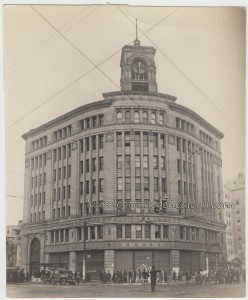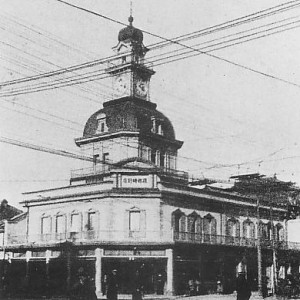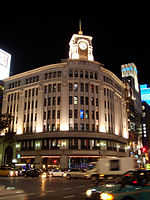This is an old photo of what is now commonly called the Ginza Wako Building in Tokyo, Japan. It would have been taken during the Allied Occupation, which was from 1945 to 1952; during this time, the building served as the Toyko PX store. If you enlarge the image, and look on the lower center facade, just above the pedestrians, you can see that it shows “U.S. Army” and something underneath starting with “U.S.A.” but the rest is difficult to make out. We also see two army jeeps on the left.
The beautiful Neo-Renaissance structure, with it’s curved granite facade, was designed by Jin Watanabe, and completed in 1932. It is one of the few buildings in the Ginza District that survived the bombings of WWII. This photo is wonderful also for another reason: If you glance at the building in the background, on our right, there is a very interesting optical illusion happening. Check it out!
The predecessor to the above building was the Hattori Clock Tower a.k.a. the K. Hattori Building, another beauty, but of vastly different style, as one would presume from it’s time frame of construction. It was a jewelry and watch store owned by Kintaro Hattori, and stood from 1894 to 1921. This tower contained a manually operated bell while the modern day building’s clock tower plays the Westminster Chimes.
K. Hattori Building in the Meiji Era which stood from 1894 – 1921. (photo from Wikipedia)
In 1921 the Hattori Clock Tower building was demolished to build a new one, but reconstruction was delayed due to the Great Kanto Earthquake, which occurred on September 1, 1923. Kintaro Hattori produced the first watches in Japan under the name of Seikosha, which later became the well-known Seiko. Below is a modern day nighttime photo (from Wikipedia.)
The Ginza Wako, owned by Wako Co., Ltd., a subsidiary of Seiko Holdings Corporation; located in the Ginza shopping district; a luxury department store whose offerings include watches, jewelry, chocolate, porcelain, dishware, handbags, upscale foreign goods, and whose sixth floor contains an art gallery.
Old photo, circa 1945 – 1952. Size: About 3 and 3/4 x 4 and 3/8″
Price: $30.00
Sources: Wako (retailer). n.d. http://en.wikipedia.org/wiki/Wako_%28retailer%29. (Accessed February 19, 2015).
File: K Hattori Building in Meiji era.JPG. n.d. http://commons.wikimedia.org/wiki/File:K_Hattori_building_in_Meiji_era.JPG. (Accessed February 20, 2015).
Muza-chan. “Sightseeing Tokyo – Wako Department Store.” Muza-chan’s Gate to Japan, January 19, 2010. Web accessed February 20, 2015.




Leave a Reply